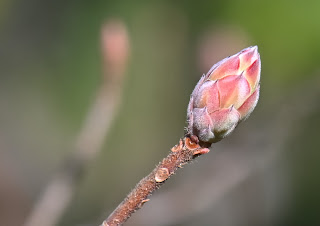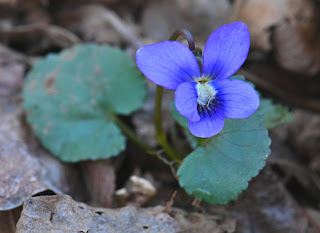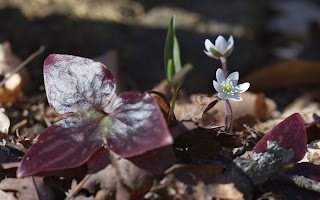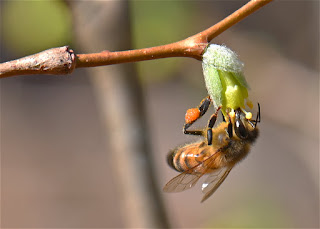Leader for today's Ramble: Linda
Link to Don's Facebook album for this Ramble. All the photos that appear in this report, unless otherwise credited, were taken by Don Hunter.
Today's report: was written by Linda and Dale, based on notes taken by Don.
Link to Don's Facebook album for this Ramble. All the photos that appear in this report, unless otherwise credited, were taken by Don Hunter.
Today's report: was written by Linda and Dale, based on notes taken by Don.
Number of Ramblers today: 43
Today's emphasis: Plants emerging in the Dunson Native Flora Garden.
Reading: March 1st entry from An Almanac for Moderns by Donald Culross Peattie. and modified to be gender neutral.
Show and Tell:
Today's emphasis: Plants emerging in the Dunson Native Flora Garden.
Reading: March 1st entry from An Almanac for Moderns by Donald Culross Peattie. and modified to be gender neutral.
March First
Now is that sweet unwritten moment when all things are possible, are just begun. The little tree has not quite leafed. The mate is not yet chosen. To the ramblers in the woods all that they can find in heavy books will be of less worth than what they learn by sitting on a log and listening to the first quiver of sound from the marshes, or by prodding with a stick at the soil and turning out the sluggish beetles. It is good enough just to sit still and hold your palm out to the sunlight, like a leaf, and turn it over slowly, wondering:
What is light? What is flesh? What is it to be alive?
What is light? What is flesh? What is it to be alive?
Show and Tell:
 | |
| Thorny Olive "cane" hanging on the beam where Gary threw it. |
Gary Crider, one of our long time Ramblers, brought us a single "cane" from a Thorny Olive, Elaeagnus pungens, (pronounced: E-Lee-ag-nus pun-gens). Thorny Olive is an invasive plant species and Gary removes it for the Garden. He brought a long shoot that had numerous short side shoots, each ending in a leaf. Each of the side shoots was inclined downward which enables the longer stem to hook over the branches of surrounding trees. Gary demonstrated how this enables the plant to literally climb into a tree by throwing his sample into the air under the pergola. Sure enough, one of the side shoots hooked over one of the pergola beams.
Today's Route: From the Children's Garden pergola we headed down the sidewalk through the Lower Shade Garden, leaving the sidewalk at the mulched path that leads down to the Dunson Native Flora Garden. We moved through most of the garden paths before returning to the Children's Garden.
OBSERVATIONS:
Anthocyanin.
Robert Frost’s famous poem, Nothing Gold Can Stay, always comes to mind this time of year, when every twig and bud seems ready to burst into life. Here is the first stanza of the poem:
Nature’s first green is gold,
Her hardest hue to hold.
Her early leaf’s a flower;
But only so an hour.
Her hardest hue to hold.
Her early leaf’s a flower;
But only so an hour.
And yet to my eye, here in the Georgia Piedmont, nature’s first green is…red. From the blush pink of the Piedmont Azalea’s bud scales to the scarlet blaze of Red Maple flowers and fruits to the deep burgundy of Painted Buckeye’s emerging leaves, red is the color of early spring. We owe these fleeting hues to a plant pigment called anthocyanin.
Everyone knows about chlorophyll, the pigment that gives plants their greenness. We learn in basic biology classes that chlorophyll absorbs red and blue wavelengths of light and reflects the green wavelengths back to our eyes. Less well known and understood is another plant pigment called anthocyanin. Although debate still rages in the pages of botanical journals, there is an emerging consensus that anthocyanins are not just incidental byproducts of plant biochemistry, as previously thought, but are in fact critical to the survival of many plants. More and more roles for anthocyanin are being identified, among them: alerting migratory birds to autumn fruits hidden among red and orange leaves; warning hungry insects away from possibly toxic leaves and fruits; and, camouflaging leaves to some color-blind mammal herbivores.
In early spring, anthocyanin appears to play the important role of protecting tender new growth from sun damage. New growth in our Piedmont forests emerges while the canopy is still bare, allowing strong white light to reach the forest floor. To a certain degree, this is good: photosynthesis can gear up and plant growth and reproduction can commence. But too much of this good thing can inhibit the plant’s ability to conduct photosynthesis. Anthocyanin limits the amount of light that reaches the plant’s photosynthetic machinery by reflecting the red and blue wavelengths and by absorbing ultraviolet radiation.
 |
| Pink bud scales of the Piedmont Azalea protect developing tissues |
 |
| Camellia flowers with showy stamens are luring several pollinators, including Western Honey Bees and Common Flower Flies. |
Camellia flowers with stamens may produce fruit in late summer. However, some of the Camellia varieties in the Shade Garden have “doubled” flowers that are prized by horticulturists. Doubled flowers have lost their stamens due to a mutation that converts stamens into petals; mutated plants are then selectively bred for the nursery trade. Doubling has been known to horticulturists since the 3rd century BC and is responsible for many popular ornamentals such as roses and carnations. Doubled flowers are of no interest to insects since the nectaries are covered by petals and the pollen-producing stamens are nonexistent.
 |
| Common Flower Fly drinking from a large water droplet on a Camellia leaf. |
 |
| Chattahoochee Trilliums are always the first trillium to flower in the Dunson Garden. |
Chattahoochee Trillium is native to the Coastal Plain of southwest Georgia and adjacent parts of Florida and Alabama. Its early emergence in the Piedmont testifies to its deep south origin. It is distinguished by its long stalk, almost twice as long as its leaves, and by the bright silvery-white stripe down the midvein of each leaf. Here in the Dunson Garden, it has been brought together with the Sweet Betsy Trillium, a Piedmont species that has shorter stalks and no midvein stripe, a co-occurrence that is rare in the wild. Trilliums in Dunson that seem to have traits of both these species are probably hybrids. Note the deep red of the stems–anthocyanin at work!
 | |
| Sweet Betsy Trillium has mottled leaves and sessile flowers but lacks the silvery stripe down the midvein. |
Chattahoochee Trillium and Sweet Betsy Trillium belong to the subgroup within the genus Trillium that has mottled leaves and flowers that sit directly on top of the leaves (sessile flowers). The flowers range in color from deep maroon to a bronzy yellow. Georgia has about 24 Trillium species, more than any other state; about 12 species of these are sessile trilliums.
 | |
| Leaf of Painted Buckeye emerging from the protection of its red and green bud scales. Buckeyes have opposite twigs and leaves; this pattern can also be seen in the arrangement of the bud scales. |
 |
| Golden Ragwort buds enclosed by purple-tinged bracts. |
The bracts – small, leaf-like structures -- that enclose the flower heads of Golden Ragwort are suffused with reddish purple anthocyanin pigments that protect the developing flowers within from sun damage. Interestingly, the basal leaves (not shown here) are also tinged with purple on the lower surface. The function of anthocyanin on the undersides of leaves (such as those of Cranefly Orchid) is still being researched.
Leatherwood is a deciduous shrub in the Thymelaceae family, and is the only native member of this family in the U.S. (Edgeworthia or Paper-bush, an ornamental exotic shrub whose incredibly fragrant flowers perfume the winter garden, is also in this family.) Leatherwood occurs infrequently in moist deciduous forests from the Florida Panhandle north to Nova Scotia and southern Quebec. Named for its flexible stems and very tough bark, Leatherwood was used by Native Americans for making baskets, bow strings, sandals, and rope.
 | |
| Spring Beauties, a true harbinger of spring at the Botanical Garden, opened its tiny pink and white flowers this week. |
Virginia Spring Beauty with narrow leaves and Carolina Spring Beauty with diamond-shaped leaves both occur in the Dunson Garden. They are “spring ephemerals,” plants that emerge in early spring, quickly flower and fruit, then disappear, having completed their entire life cycle in the space of a few weeks. The flowers are visited by both female and male Spring Beauty Bees (Andrena erigeniae) which collect pollen only from Spring Beauties. The female bees form the pink pollen into balls and deposit them in underground chambers along with their eggs. As temperatures warm, the larvae emerge and eat the pollen balls. The larvae pupate during the summer and develop into adults by late fall. Adults spend the winter underground, emerging in the spring when they mate on the petals of Spring Beauties.
 |
| Walter’s Violet flowers are small, blue or purple, with a white throat. |
Walter’s Violet is an early spring bloomer. Its runners spread from a cluster of leaves, forming small colonies. The heart-shaped overwintering leaves are dull green with dark veins; the lower leaf surface usually has purplish veins or a tinge of purple near the base. The leaf tips are rounded and the margins are finely toothed. This is an easily overlooked plant with small blue flowers and is often mistaken for the much larger, glossy-leaved Common Blue Violet (Viola sororia).
 |
| A new Bloodroot flower emerging from a furled leaf.: |
 |
| Cut-leaf Toothwort is coming into its own, with its pink, anthocyanin-protected buds opening into white flowers. |
Cut-leaf Toothwort is a member of the Brassica (Mustard) family that includes many of our cool season vegetables such as mustard and collard greens. Toothwort’s leaves and underground stems are also edible, with a sharp taste much like turnips.
 | ||
|
Plants of the mustard family contain compounds called glucosinolates that give them a pungent taste. But some herbivores have evolved ways to eat mustards. One of our butterfly species, the Falcate Orangetip, emerges in early spring and searches for mustards like toothworts to lay their eggs on. Although we did not see one today, Orangetips have been seen in the Dunson Garden before. Look for them during the next two weeks.
 | |
| A group of Trailing Trillium hugging the ground. |
Trailing Trillium or Decumbent Trillium. A small cluster of Trilliums appeared to be stemless, the leaves hugging the ground. But they do have stems - they are just lying flat on the ground. That's where the "decumbent" in the specific name comes from. When the stem emerges from the ground it bends 90 degrees and further elongation results in it creeping along under the leaf litter. After growing horizontally several inches the bud end bends 90 degrees upward and emerges through the leaf litter.
 | |
| Green and Gold Normally there are five yellow florets. |
Green and Gold. This link to the Clemson University Factsheet for Green and Gold is a gold mine of information about the varieties, propagation and characteristics of this winter-green species. It can be used as a ground cover in place of plants like English Ivy.
 | |
| Flower buds of Dwarf Pawpaw |
Dwarf Pawpaw (Asimina parviflora) is the smaller, shrubbier cousin to the bigger Pawpaw, Asimina triloba. In both species the flower buds open before the leaf buds swell. The buds will open soon, if the warm weather keeps up. The petals are a deep wine red or purple in color. This reminded early investigators of rotting meat and they assumed that carrion flies were the chief pollinators. But, more recently, chemical analysis of the volatile compounds emitted by the flowers is more consistent with fermentation. It seems likely that the principle pollinators are flies and midges that feed on fermenting plant material.
The larger Pawpaw species is not planted in the Dunson Garden, but a "Pawpaw patch" can be found next to the sidewalk across from the Heritage Garden.
 | |
| Georgia Dwarf Trillium |
 |
| The leaf lobes of Sharp-lobed Hepatica are not as rounded as those of its close relative, Round-lobed Hepatica. |
 | |
| Flowers of Little Brown Jugs are under the leaf litter. These are pink (with anthocyanin?) and should turn brown later. |
Little-brown Jug hides its flowers under the leaf litter. Why would any plant bury its flowers out of sight? Flowers are supposed to attract pollinators like bees, flies, butterflies or moths. Hiding the flower under dead leaves would seem a poor strategy for attracting pollinators.
How do we discover what pollinates a flower? Normally you sit and
watch, but that strategy fails when the flower is out of sight. If you remove
the litter so that you can see the flowers you disturb the area so much that
the normal pollinators, whatever they are, may not appear. So people who have
investigated this question have resorted to indirect methods. They have
enclosed the plants or just the flowers in cages that exclude insects to see if
seeds are still produced. Caged plants do produce
seeds, but not as many as uncaged plants. This indicates that these flowers are
capable of self-pollination, but that more seed can be produced when
pollinators are have access to the flowers. The actual pollinators remain unknown, but possible candidates are ants, beetles or fungus gnats.
 | |
| A tachinid fly visiting the staminate (male) flowers of a Spicebush. All the flowers of a single plant are of the same sex. |
 |
| Female flowers of Spicebush. The pistils with their style and stigma are clearly visible. All the flowers on a single Spicebush plant are the same sex. |
Spicebush is an early blooming shrub that is unusual in having the sexes on separate plants. Approximately 7% of the flowering plant species have this arrangement of the sexes.
Mary Anne Borge has a beautifully illustrated blog post that explores the Spicebush and its interactions with other organisms. All Ramblers should take a look; it can be found at this link.
 | ||
| Seersucker Sedge inflorescences Staminate florets on top, Pistilate flowers below |
 |
| Pistilate florets close up |
 |
| Staminate florets closeup |
Seersucker sedge, like other sedges, is monoecious, bearing different sexes in different areas.
Gender arrangements in flowering plants.
The typical flower, as taught to most of us at an early age, has two reproductive parts: the stamens and the pistil. The stamens produce pollen and are usually considered the plant's male reproductive structures. The pistil (or pistils) produce the seeds, so they are considered to be the female structures. The "typical" flower has both stamens and pistils. Such a flower is termed bisexual or "perfect" and the plant that bears such flowers is termed "hermaphroditic."
Those of you who have grown zucchini may have observed that only some flowers on a plant produce a squash. They are the ones that have a swelling at the base of the flower. The swelling is the ovary, the part of the pistil that produces the seeds and the squash. Those other flowers have stamens but no pistils. The flowers in plants like zucchini are all unisexual, i.e., not "perfect."
A plant with imperfect flowers of both sexes is termed "monoecious," (pronounced: "moan-EE-shus").
Examples of monoecious plants are: oaks, corn and sedges,
A third arrangement of genders in plants is found in Spicebush: all flowers are unisexual and each plant has flowers of one sex only. This condition is termed "dioecious", pronounced: "dye-EE-shus."
Examples of dioecious plants are: hollies, Spicebush and Wax Myrtle.
Why so many gender arrangements? One of the things that may play a role in the evolution of monoecy and dioecy is the avoidance of self-fertilization. All plants and animals carry recessive genes that are unfavorable when brought together. Self-fertilization greatly increases the chances producing such genetic problems and monoecy and dioecy reduces those chances. But what about hermaphroditic plants? They reduce the chances of producing unfavorable genetic combinations by self incompatibility. In many plants self-pollen will be prevented from fertilizing ovules of the same plant.
 |
| Virginia Bluebell flower buds are pink but change color to blue when opened. |
Virginia Bluebells
 |
| Rue Anemone |
Rue Anemone is found scattered throughout the Dunson Gardem. Larger areas of abundance can be found along the Orange Trail and the White spur Trail.
 |
| Carolina Anole |
Carolina Anoles become active with warmer temperatures. They change color from brown to green and vice versa. It is thought that the brown color phase helps absorb heat from the sun. The change from one color to another is not immediate, it takes about 5 to 10 minutes, depending on temperature. The green color is thought to be concealing coloration when clambering among vegetation. They also are green when stressed. These ideas are best thought of as hypotheses, rather than proven facts.
SUMMARY OF OBSERVATIONS
Piedmont Azalea Rhododendron canescens
Camellia Camellia japonica
Western Honey Bee Apis mellifera
Common Flower Fly Syrphus ribesii
Chattahoochee Trillium Trillium decipiens
Painted Buckeye Aesculus sylvatica
Florida Anise Illicium floridanum
Sweet Betsy Trillium Trillium cuneatum
Golden Ragwort Packera aurea
Black Cohosh Actaea racemosa
Leatherwood Dirca palustris
Carolina Spring Beauty Claytonia caroliniana
Virginia Spring Beauty Claytonia virginica
Walter's Violet Viola walteri
Bloodroot Sanguinaria canadensis
Trailing Trillium Trillium decumbens
Cut-leaf Toothwort Cardamine concatenata
Green-and-Gold Chrysogonum virginianum
Dwarf Pawpaw Asimina parviflora
Georgia Trillium Trillium georgianum
Sharp-lobed Hepatica Hepatica acutiloba
Allegheny Spurge Pachysandra procumbens
Little Brown Jugs Hexastylis arifolia
Spicebush Lindera benzoin
Rue Anemone Thalictrum thalictroides
Carolina Anole Anolis carolinensis
Seersucker sedge Carex plantaginea

